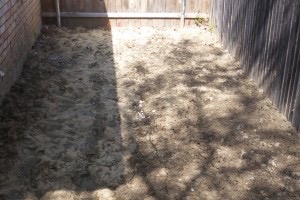Homeowners almost always assume they need foundation repair when they are seeing symptoms of movement and settlement to their home. A good foundation repair company will work hard to determine the cause of the movement so that they can design the proper solution, which oftentimes doesn’t actually involve any foundation repair. Stratum was recently consulted and contracted to help eliminate excessive movement of home foundations in the Dallas – Fort Worth area. What follows is a case study of how that process unfolded, with special attention given to proper house foundation drainage.
THE PROBLEM | Part 1 of a 4 Part Series
In Corinth, Texas, a single story residential property built in 1993 was suffering from excessive foundation movement. The excessive movement was causing many of the same results we see around the Dallas – Fort Worth area, things like sheet rock cracks, brick cracks, cracks in crown molding, doors and windows out of alignment, etc. A trained eye can tell based on the orientation of various cracks which part of the house is lower. When visually observing the cracks and other symptoms it became apparent to us these issues were not being caused by the typical foundation problems in Texas, which is settlement of the perimeter beam. The cracks and out of aligned doors made it obvious to us that the interior of the home was actually lower than the perimeter of the home. This belief was confirmed when we took floor elevations using a Zip level. Our measurements revealed the perimeter of the home to be 1-3 inches higher than the interior. These measurements are relative to one another and have no true baseline. All we were able to say at this point was that the interior was lower than the perimeter. We could not conclusively say whether the interior was sinking or the perimeter was raising. We would need to investigate further to try and determine the cause of the distress, as well as find the proper solution.
Next we will reveal what our investigation turned up.
THE INVESTIGATION | Part 2 of a 4 Part Series
The typical foundation settlement we see in the Dallas – Fort Worth area is settlement around the perimeter of the home. This is due to the ever changing moisture content around the outside of the home. North Texas weather patterns tend to leave us in a perpetual state of drought. This lack of moisture causes the perimeter of homes to sink, or settle. Under this typical scenario, we are called out to follow our foundation repair process under the exterior beam of the home to prevent any further sinking, and when possible raise the home back to its “as built position.”
It is much rarer that we deal with interior settlement. Moisture content beneath the middle of the home should stay relatively consistent throughout the year as the soil underneath the home is not exposed to the weather. However, we do occasionally come across a house that is lower in the middle relative to the perimeter. The question then becomes, “Is the middle of the home sinking….or is the perimeter raising, or heaving?” There are several things that can cause the interior of the home to sink, but the most frequent thing we see causing this scenario is large trees planted too close to the home. The roots grow beneath the home, thus depleting the otherwise stable moisture content beneath the home. Other factors that cause excess movement under the interior of a home are plumbing leaks. While a plumbing leak will generally result in upwards movement due to excess moisture being released beneath the house there are cases where the leak can cause soil to wash out and erode, which can result in interior settlement.
Much like with interior settlement there are many factors that can cause the perimeter of a home to heave(old piers heaving, improper drainage, etc.). Generally if the perimeter of the foundation is heaving it is because there is too much moisture collecting around the foundation, and this is generally due to improper drainage around house foundation.
Now then, back to the house under investigation…..
To restate: Visual cues, along with Zip Level readings, indicated to us that the interior of the home was lower relative to the perimeter. The question was why, as well as the afore mentioned, “Is the interior sinking, or the perimeter heaving?” Step one was to have a plumber out to verify there were no leaks under the slab. After having a hydrostatic pressure test performed on the sewer line as well as a check performed on the fresh water line we were able to rule out that a plumbing leak was the cause of the movement we were seeing. A visual inspection was able to verify that no trees or other vegetation were deemed to be too close to the home or otherwise detrimental to the performance of the foundation.
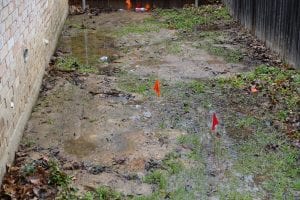
What became apparent while observing the conditions around the house was that there was very poor drainage around the house foundation. The home had no grading that would allow the water to run away from the home. Furthermore the house had gutters, but the downspouts simply dumped the water right along the perimeter of the home. There was nowhere for excess moisture to drain after rainfall or yard watering. This problem was easily observed after viewing the house one afternoon following heavy rainfall. Water gathered and pooled alongside the house with nowhere to go. It became obvious that the most likely cause of the foundation problem was upheaval around the perimeter caused by poor drainage. The solution would therefore involve finding a way to rectify the poor drainage around foundation, and eliminate the excess moisture around the home. This is the best way to avoid the future need for Plano foundation repair, or any other city across DFW.
Our next installment will reveal our solution as well as detail the installation process.
THE SOLUTION | Part 3 of a 4 Part Series
At this point we knew that both sides of the home needed proper foundation drainage. While both sides of the home had drainage issues the solution would vary slightly. The North side of the property is being harmed due to runoff from the neighboring yard, causing water to pool and stagnate. On the South side both this lot and the neighbor’s lot are level resulting in less total accumulation, but still problematic due to the flat grading not allowing for runoff. The goal is to take the excess water on both sides of the home and move it to the street. On the North side we opted to install a french drain due to the fact that the north side is seeing the most water. The excess water pooling means that the soil has already soaked up as much as it can. (Special Note: if you use a soaker hose for foundation, make sure your watering schedule is adjusted to excess rainfall.) A french drain will help against the pooling as well as pull the excess moisture out of the soil. On the south side there isn’t as much pooling, so we were able to install an area drain and connect the existing gutter downspouts to the drain system. Utilizing both french drains and area drains would allow both sides of the property to stabilize and maintain a more uniform moisture content.
Drain Definitions: The Two Main Options For Drainage Problems Around the House
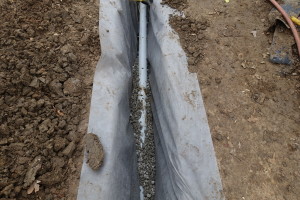
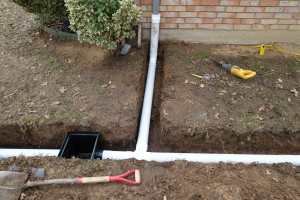
Fixing the Drainage Around House Foundations:
Are you unsure of which type of drainage solution is best to facilitate the drainage around foundation? We can help. Let us take a look at your property situation, and advise you on the best solution that is right for you. Contact Stratum today: 214-683-2956
Installation Process:
Area Drain
Below are images showing an area drain used to fix drainage issues around the house.
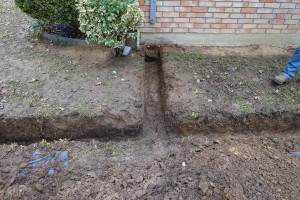

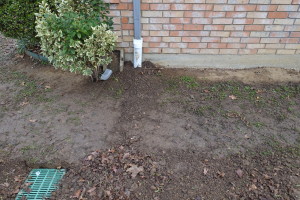
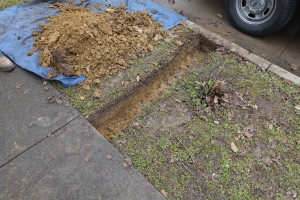
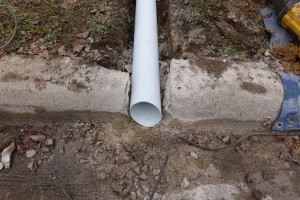
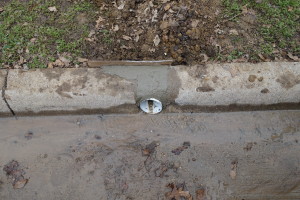
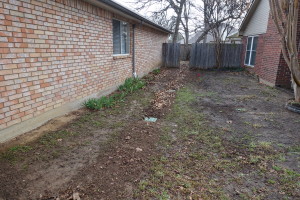
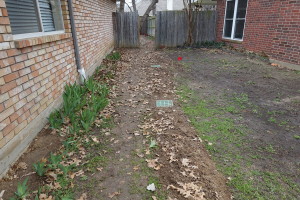
Remember, an area drain has water grates at set places or “areas” where water tends to pool. You can see identify this is as an area drain in this Dallas area home by spotting the green grate to correct drainage around the house in the problem area.
French Drain
The below images show why french drains outside the house are commonly used in the Dallas area. Water can enter through small holes all along the pipe, providing the most surface area to channel water away from the property. This is one reason why french drain installation in Dallas is on the rise.
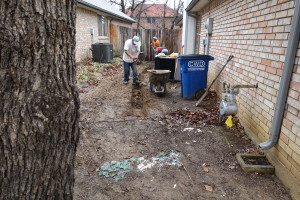
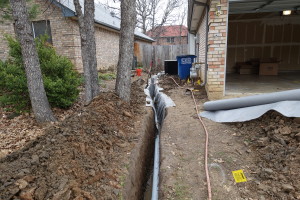

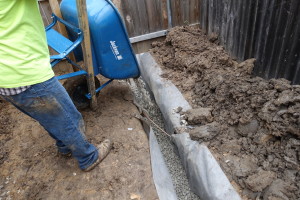
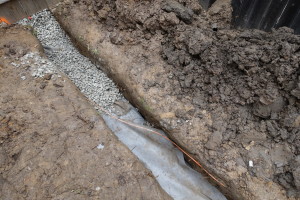
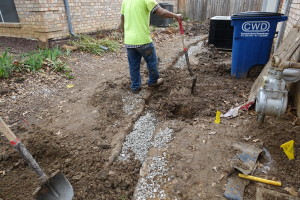
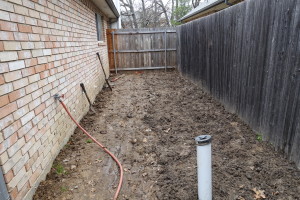
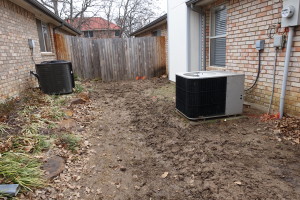
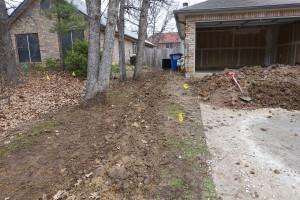
If you are considering french drain installation for proper drainage around your foundation, get in touch for a free estimate. We will also take a look at your overall house foundation drainage to confirm it’s the best option for you.
RESULTS: Proper Drainage Around Foundation |
Part 4 of a 4 Part Series
It has been several months since we have completed the drainage installation. We have experienced near record rainfall since the installation of the drains so we were excited to inspect the drainage to make sure that it was performing as intended. As you can see in the picture the ground is definitely not holding as much water as before. The measurements are also starting to creep down towards normal levels, although it can take many seasons for them to get back to where they need to be.
Before: 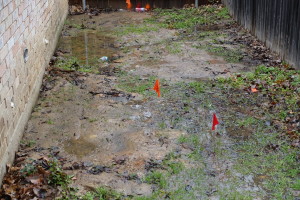
With the long term drought that we have been in over the last several years most people don’t realize the amount of shrinkage in the soil that has taken place over that time. One good week or month of rain can cause that soil to expand rapidly. It is the inconsistency in the moisture levels from the interior to the perimeter that can cause cosmetic and structural damage to the house. We see this routinely all across DFW, causing the need for foundation repair in Dallas, all the way North to Allen, McKinney, and Frisco. We urge everyone to take a look outside the next time it rains and see if you notice any standing water next to the house, or if you notice any small hairline cracks pop up after a good rain. These can be signs of foundation problems, and it might be your house trying to tell you that your drainage isn’t up to par.
If you believe you might have a drainage problem give Stratum a call and we’ll send out an inspector to give you a FREE evaluation!
Call Today: 214-683-2956
